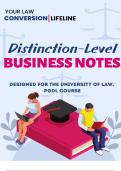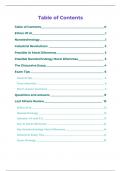Summary
Summary Business Law Notes (DISTINCTION) for University of Law Post Graduate Diploma in Law (PGdL) course
- Module
- Business Law
- Institution
- University Of Law (ULaw)
Distinction level Business Law (Law of Organisations) notes (overall grade, 80). Crafted by a recent graduate who received a distinction in the very same course, these notes are tailored to your PGDL program, ensuring they cover the crucial Business Law concepts you need to master. Aligned w...
[Show more]












